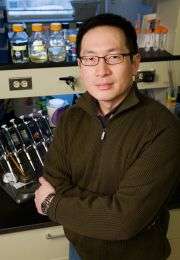Scientists fool bacteria into killing themselves to survive

(PhysOrg.com) -- Like firemen fighting fire with fire, researchers at the University of Illinois and the University of Massachusetts at Amherst have found a way to fool a bacteria's evolutionary machinery into programming its own death.
"The basic idea is for an antimicrobial to target something in a bacteria that, in order to gain immunity, would require the bacteria to kill itself through a suicide mutation," said Gerard Wong, a professor of materials science and engineering, of physics, and of bioengineering at the U. of I.
Wong is corresponding author of a paper accepted for publication in the Proceedings of the National Academy of Sciences. The paper is to be posted this week on the journal's Web site.
The researchers show that a synthetic "hole punching" antimicrobial depends on the presence of phosphoethanolamine, a cone-shaped lipid found in high concentrations within Gram-negative bacterial membranes. Although PE lipids are commandeered to kill the bacteria, without the lipids the bacteria would die, also.
"It's a Catch-22," Wong said. "Some mutations bacteria can tolerate, and some mutations they cannot tolerate. In this case, the bacteria would have to go through a mutation that would kill it, in order to be immune to these antimicrobials."
In their work, the researchers compared the survival of the bacterium Escherichia coli with that of a mutant strain of E. coli, which lacked PE lipids in its membrane. The fragile PE-deficient mutant strain out-survived the normal, healthy bacteria, when exposed to a "hole punching" synthetic antibiotic.
However, the opposite was true when both strains were exposed to tobramycin, a conventional metabolic antibiotic that targets the bacterial ribosomal machinery rather than the membrane.
The researchers first reported on compounds that functioned as molecular "hole punchers" last year in the Journal of the American Chemical Society. Their latest work further elucidates the "hole punching" mechanism.
"The antimicrobial re-organizes PE lipids into holes in the membrane," said Wong, who also is a researcher at the university's Beckman Institute. "The perforated membranes leak, and the bacteria die."
Finding new ways to treat emerging pathogens that are more and more resistant to the best antibiotics will be increasingly important in the future, Wong said. "Now that we more fully understand how our molecular 'hole punchers' work, we can look for similar ways to make antimicrobials that bacteria cannot evolve immunity to."
Provided by University of Illinois at Urbana-Champaign

















